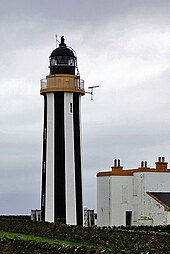Sanday
| Sanday | |
|---|---|
| Aerial view of Sanday | |
| Waters | North Sea |
| Archipelago | Orkney Islands |
| Geographical location | 59 ° 15 ′ N , 2 ° 34 ′ W |
| length | 20 km |
| width | 8.5 km |
| surface | 50.43 km² |
| Highest elevation | The Wart 66 m |
| Residents | 494 (2011) 9.8 inhabitants / km² |
| main place | Kettletoft |
| Sanday Airfield | |
Sanday (Eng. "Sand Island") belongs to the Scottish Orkney Islands . It is located about 28 km northeast of the island's capital, Kirkwall . The Viking name of the almost treeless, flat island (the highest point is 66 m) indicates the island's sandy beaches.
With a length of 20 km and a maximum width of 8.5 km, it is the largest of the northern Orkney Islands with an area of 50.43 km². The coastline is very long due to narrow headlands and deep bays. Sanday has a mild climate (temperatures between 0 and 20 ° C), but is exposed to strong winter storms. The island is surrounded by some groups of small uninhabited islands (Holmes) ( Holms of Ire , Holms of Spurness ), which are bird paradises and seal sanctuaries .
In 2011, Sanday had 494 residents. The main settlement areas are Kettletoft , where the ferry docked until 1992, and Roadside, also known as " Lady Village ". Most of the residents live in scattered houses. On Sanday there are two shops for general needs, a church, a doctor's office, two nurses, a school, two pubs, a small museum, a bicycle shop, two car repair shops, a "Village Hall" at the school and a small indoor swimming pool. The school offers kindergarten, seven elementary school classes and four secondary school classes. The island children spend the last years of school at the school in Kirkwall and can live in a special school hostel during the week. During the 1870s, the island had the highest population with around 2500 inhabitants. The abandoned village of Ortie in the north is a relic of this time .
Sectors of business are agriculture (mainly livestock farming), in addition coastal fishing, especially for mussels, crabs and lobsters, and to an increasing extent tourism.
The most famous resident of the island was the composer Sir Peter Maxwell Davies (1934-2016). The fact that the Orkney Islands Council forbade the local registrar to marry Davies and his partner Colin Parkinson on their home island attracted international attention in 2007.
traffic
There are regular ferry connections from Loth to Kirkwall and the neighboring island of Eday . Other neighboring islands ( Westray , Papa Westray , Stronsay and North Ronaldsay ) are occasionally accessible by ferry during the summer. There are also daily scheduled flights to Mainland and Stronsay. Due to the distance, it is difficult to see all of the sights on Sanday in one day.
There is a public minibus service on Sanday that takes passengers to and from the ferry upon request.
Rental bikes are available.
Attractions
In addition to the natural beauties such as the rare plants and the sandy beaches, which are often populated by seals, there are numerous archaeological sites.
The Quoyness Cairn on the Elsness peninsula , a Maeshowe-type complex, bears witness to Neolithic settlement . The plant from the 3rd millennium BC Chr. Is very well preserved and has an interior height of about four meters. The island has three other megalithic structures , of the Stalled Cairn type . In the northeast lies the Toftsness burial ground with over 800 barrows . It is one of the largest prehistoric burial places in Northern Europe. At the end of the promontory of Tresness are Broch of Wasso. At the Old Lady Kirk there are the prehistoric “Ladie's Fingers” ( grinding grooves ). Other buildings and burial grounds, most of which have not been excavated, date from the Stone , Iron and Viking Ages .
The spectacular finds include the Viking boat grave of Scar or Quoy Banks, uncovered by the storm in 1985, with additions such as fibula , sword , sickle and spindle whorls . A plaque made of whale bones , the "Scar Dragon Plaque" (all finds are now in the Museum of Kirkwall), is particularly beautiful . Nearby is the Stone o 'Scar .
In the east is the lighthouse of "Start Point", built in 1802, which is separated from the main island at high tide. On the Tresness peninsula in the south is the farm of the same name with the well-preserved Horse Energy House , a hexagonal stone building with a pyramid roof, in which horses generate the energy to run the farm. An example of an attempt to generate the required energy using a steam engine is the now derelict Stove Model Farm in the south. The operator failed because the costs for the fuels coal and peat , which are not available on Sanday, were too high.
Two hotels, a hostel with space for caravans and tents, several accommodations and holiday apartments are available for guests.
Individual evidence
literature
- Olwyn Owen, Magnar Dalland: Scar - A Viking Boat Burial on Sanday . Tuckwell, East Linton 1999, ISBN 1-86232-080-2 .




